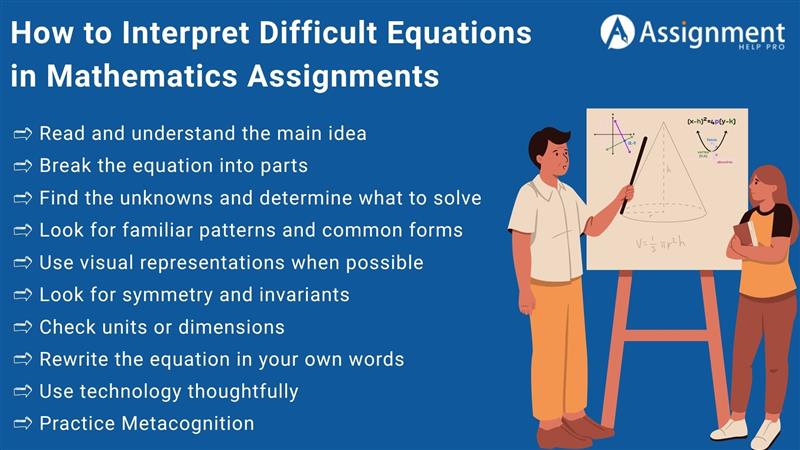Learn how to interpret complex equations in math assignments. First, break the equation into smaller parts. Next, spot patterns, identify the unknown variables, and solve one step at a time. You can also use math tools to create visuals. However, regular practice will make it easier for you to solve complex math problems.
Understanding and interpreting complex equations is one of the most challenging aspects of studying mathematics. No matter whether you are working with algebra, calculus, or other topics, the symbols and rules in math can feel confusing. But if you learn to break the equation into smaller parts and understand how it is built, you can accurately solve the mathematical problems in your assignments. Would you like to know how to interpret complex equations in mathematics assignments? If yes, read this blog. Here, we have shared simple ways to make sense of difficult equations in your math assignments. Whenever you solve problems by hand or use tools like Mathematica, by following the tips suggested, you can easily read and understand even the toughest math expressions.
How to Interpret Difficult Equations in Mathematics Assignments
Complex math equations can seem hard to understand, but breaking them into smaller steps can help a lot. Here is how to approach and interpret tough math equations with confidence.
1. Read and understand the main idea
Before you solve a complex equation, clearly understand what it is about. Ask yourself what type of math it involves, such as algebra, calculus, or statistics. Think about whether the equation represents a function, a system, a model, or a change. Also, try to figure out what the equation is meant to do in the problem. Generally, understanding this will help you choose the right approach to solve it. For example, a physics equation might describe motion. But in data analysis, it could reveal patterns or trends.
2. Break the equation into parts
After you understand what the equation is about, break it into smaller parts to make it easier. Look at the letters and figure out what they stand for. Notice the math signs like plus, minus, multiply, divide, and powers. Look for any functions, such as sine or exponential terms.
Pay attention to brackets, since they show which parts to solve first. Also, watch out for symbols that show if things are equal or not. Highlighting or labeling each part can help you stay organized and understand the equation better.
3. Find the unknowns and determine what to solve
In most math assignments, you will be solving for unknown values, simplifying expressions, evaluating functions, or proving statements. So, make sure of what you need to do. If the equation has more than one unknown, check if there are other related equations or if the problem suggests a specific method to use, such as substitution or matrix operations.
4. Look for familiar patterns and common forms
Complex equations often follow certain patterns or look like common types you have seen before. For example, quadratic equations have the form ax² + bx + c = 0, and differential equations might look like dy/dx + P(x)y = Q(x).
Recognizing these patterns will help you identify which method to use to solve the problem. Whenever you spot a familiar form, without hesitation, use a known formula or theorem instead of starting from scratch. If it is challenging for you to spot the pattern, you can get Math Assignment Help from experts online.
5. Use visual representations when possible
One of the best ways to understand complex equations is by visualizing them. If possible, you can use any of these to represent visually
- Graphs: Drawing the equation helps you see how it works, like how a parabola curves or where a function crosses the x-axis.
- Tables: Creating tables of values can show patterns in functions or sequences.
- Flowcharts and Diagrams: These are helpful when solving problems with many steps, like in linear algebra or logic.
Seeing equations visually will help you understand complex math equations better. You can use Mathematica for creating visuals. It is a great tool for making graphs and pictures and handling complicated math symbols. If you have no idea how to use the tool, get Mathematica assignment help from experts online. They will assist you in representing the equations visually.
6. Look for symmetry and invariants
Mathematicians often try to find patterns like symmetry or things that don’t change when performing certain operations. For example, in calculus, functions can be even or odd; in linear algebra, some matrices are symmetric; and in physics-related math, certain quantities stay the same because of conservation laws. Noticing these patterns can make equations easier for you to solve or help narrow down the possible solutions.
7. Check units or dimensions
When equations come from applied science fields like physics, engineering, or economics, checking the units is very helpful. Make sure the units on both sides of the equation are the same. This is an easy way to find mistakes or understand what each part of the equation means.
8. Rewrite the equation in your own words
A helpful but often forgotten method is to translate the equation into natural language, i.e., explain the equation in simple words. For example, the formula A = P(1 + r/n)^(nt) means “the compound interest for an amount P with interest rate r, compounded n times a year for t years.” Putting the equation into words will help you understand what each part means and how it works.
9. Use technology thoughtfully
Tools like Mathematica, MATLAB, and Wolfram Alpha can help you with algebra, solve equations, and even show the steps involved. However, it is important not to rely on these mathematical tools without thinking. Use them to check your work, not to do everything for you. Also, make sure your teacher allows these tools, because sometimes you need to show how you solved the problem by hand. When used the right way, these tools, along with professional assignment help services, can help you understand difficult problems and check your answers, especially when you are stuck.
10. Practice Metacognition
As you solve the equation, keep checking if each step makes sense and fits with what you did before. Think about what might happen if you change a variable, and make sure you are simplifying correctly. Getting into the habit of thinking carefully about your work will help you avoid mistakes and get better at solving problems over time.
Final Words
By following the tips suggested in this blog, you can interpret complex math equations. Interpreting complex equations is not just about solving problems; it is about learning to read and think mathematically. This skill improves with practice, curiosity, and breaking big problems into smaller parts. If you ever feel stuck, get our math assignment help services. The experienced math assignment helpers in our team will explain to you the concepts and guide you in solving all types of mathematical assignment problems. Especially with their assistance, you can find accurate answers, finish the assignments on time, and secure top grades.





